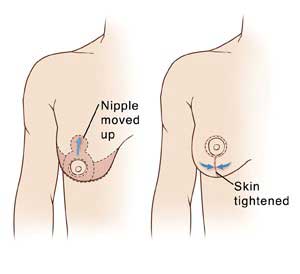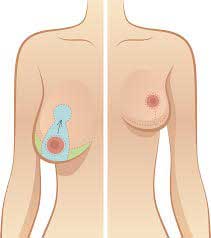Women may experience a decrease in breast volume and drooping (ptosis) for several reasons, including pregnancy, weight loss, aging, or even genetics. When breasts sag, their volume decreases and the skin around the breasts stretches. As a result, the breasts lose their freshness and youth. Breast lift operation (mastopexy) can place the breast in its proper position on the chest, tighten the breast skin and even change the size and shape of the breast and areola and make it beautiful. Today, there are techniques by which the breasts can be lifted out of sagging. These methods, which are usually known as mastopexy, have different techniques, including breast enlargement, breast lift or its tip, or a combination of these methods. Depending on the conditions and appearance of the breasts, the methods used for the lift are different. Before performing the operation, the surgical team checks the condition of the breasts and suggests the appropriate technique for breast lift.

Who need a breast lift or mastopexy?
Breast shaping is one of the results of breast lift. Usually, after a face-to-face consultation, I, Dr. Gholamhossein Ghorabi, a subspecialist in plastic, cosmetic and reconstructive surgery, will determine whether your breasts need a lift or not. However, physical and appearance factors that determine a person’s need to undergo mastopexy include:
• Breasts without volume or firmness
• The tissue under the breast is wrinkled
• The nipple should be down
• The nipples are placed under the breast fold
• Asymmetry in the size and shape of the breasts
• And finally, unusual forms of breasts
The degree of breast sagging is the most important reason for mastopexy surgery. The most important factors that determine the level of breast sagging are: the position of the nipple and the amount of breast tissue sagging under the crease. Mastopexy is performed to correct sagging breasts that can occur as a result of gravitational pull, aging (reduction of breast fat and tissue), pregnancy, or weight loss. Smoking and sunburn can also affect the elasticity of the breasts. Sagging can occur in large and small breasts. While breast sagging does not affect physical health, it may affect self-confidence, and as a result, women may wish to correct ptosis and breast lifts.

Does every sagging breast require mastopexy surgery?
Breast sagging is medically called breast ptosis. Aesthetic surgeons classify sagging breasts according to the scores listed below. This classification helps to perform the breast lift operation:
Grade 1: In mild ptosis, the nipple is just below the natural border of the breast (inframammary fold) but still above the lower part of the breast.
Grade 2: With moderate ptosis, the nipple protrudes more from the lower part of the breast, but the lower part of the breasts is below the nipple.
Grade 3: With severe ptosis, the nipple is much lower than the lower part of the breast, and there is no density of tissue and protein in the lower part.

Breast lift and enhancement
Changes in breast shape and firmness often occur due to pregnancy, weight loss, or aging. Breast tissue and skin lose their ability to grow or stretch and return to their normal state (elastic state). This causes the breasts to sag and lose their shape. Mastopexy is a aesthetic surgery that is performed to change the shape of the breasts in case of sagging. It is often called a breast lift. Breast lift changes the appearance of the breasts and improves them. The most common technique used for breast lift is full mastopexy lift (Anchor Lift), which creates a scar (like an anchor) from around the breast area to under the breast and under the breast fold. A breast lift alone lifts the breasts and nipples, but also generally reduces the overall size of the breasts. Because when the breasts are lifted and the excess skin is cut, the volume of the breast is also reduced. In people who have relatively large but drooping breasts, after performing a breast lift, the breasts will reach a normal and desirable level. However, in people whose breasts are small and lack fat and tissue, but also suffer from sagging, the size of the breast may decrease after a breast lift. In this case, suitable implants can be used to restore the size and shape of the breast as well as its bulge.
Types of breast lift methods and techniques
Mastopexy may be performed in a hospital, ambulatory surgery center, or surgeon’s office. It is usually done on an outpatient basis with general or local anesthesia and takes from one to three hours. There are several incision techniques that can be used when performing a breast lift. The technique the surgeon chooses depends on the following for the patient: breast size and shape, degree of sagging, size and position of areolas/nipples, amount of excess skin, skin quality. The three most common types of incisions are:
Two rings around the areola in the shape of a donut: This type of mastopexy with a small incision is usually recommended for patients with small breasts and minimal sagging. Because in this type of cut, there is no need to remove a lot of skin and breast tissue to lift the breasts.
From around the areola to the breast fold in the shape of a lollipop: in this case, the incision is made centrally from the areola and extends linearly to the bottom of the breast fold. This type of mastopexy is suitable for moderate sagging, by which a small amount of breast fat tissue can be removed.
Anchor: In this case, which is considered the most complicated type of incision in mastopexy surgeries, it is actually a combination of the first two types of incision. In this technique, the incision made at the tip of the areola continues along a line towards the bottom of the breasts. Then it extends in the shape of a crescent to both sides of the chest and causes the skin to stretch and empty the excess breast tissue.
How to perform mastopexy (breast lift)
During the procedure, the surgeon makes several incisions in the breasts, depending on the technique he is using. The skin can be cut around the areola, under the breasts, or just one area. After making the incision in the right place, the breasts are pulled up and the nipple is also changed. In some cases, they change the shape of the areola to fit the new breast size. In this way, the breast tissue is tightened and placed in the right place (without sagging). Sometimes, breast implants can be placed during the procedure to lift and enlarge the breast. In general, during a breast lift, the surgeon makes incisions in the skin around the breast. Before the operation, the patient and the surgeon talk about the incision sites and how to do it. In this surgery, the dark skin around the nipple (areola) and the nipple moves up and the areola is fixed in place. One of the side effects of this operation is the temporary or permanent loss of sensation in the nipple. The incisions are then closed with sutures, surgical tape, or both. A tube (drainage) may be inserted into the incision area prior to closure. This will drain excess fluid that may accumulate in the breast tissue as the wound begins to heal.

How to prepare for mastopexy
In pre-surgery consultations, the surgeon will assess the individual’s breasts and take photographs (in some cases) for post-operative records and comparisons. After the examination and review, the size and position of the nipples are evaluated and the location of the incisions is determined. The method of cutting and the techniques used in practice are also discussed. Before performing a breast lift, the surgeon will explain what needs to be done to prepare for the operation.
If smoking, the patient is asked to quit smoking at least six weeks before the operation, as smoking increases the risk of infection and slows healing. Smoking affects blood supply to the skin and can slow down the wound healing process. If you smoke, the surgeon may decide to delay the surgery.
The patient should tell their surgeon about all the medications they are taking. These medicines include herbal medicines and other supplements. Also, the use of any blood thinners such as warfarin, some anti-inflammatory drugs, clopidogrel and daily aspirin should also be reported to the surgeon. Because some or all medications may need to be stopped before surgery. It is usually recommended not to eat anything six hours before the operation. Breast lift surgery is usually performed under general anesthesia.
Post-operative care
After the surgery, a suitable bra (elastic, without underwire and with adjustable straps) and a bandage must be worn for one month, and the bra can only be removed when showering. Massaging the cut and stitched area can reduce inflammation. Avoid lifting heavy objects, vigorous exercises and sudden movements. The surgery takes about 2 to 4 hours. The patient may be discharged and return home on the same day. But sometimes, depending on the patient’s condition, he may be hospitalized overnight. After returning home, any instructions given by the doctor should be followed by the patient. During recovery, prescribed medications should be taken exactly as directed. A special bra or bandage given to the patient before discharge should be used according to the surgeon’s instructions. All care, such as changing bandages, showering, etc., must be done according to the surgeon’s instructions. Swimming, using a hot tub, and any activity that causes the cut and stitches to sink into the water are prohibited until partial recovery. Gently wash your incision when you shower. Then dry the stitch. It is prohibited to use lotion, oil or cream on the incisions until they are completely healed. Do not raise your arms above chest level for 10 days. And don’t lift, push, or pull anything heavy for at least 7 days. When riding in a car, put the seat belt in such a way that your breasts are not under pressure.

Changing the location of the nipple in breast lift surgery
Note that breast swelling may last 3 to 5 weeks. If recommended by the surgeon, use a cold pack wrapped in a thin towel to relieve discomfort and control swelling. Pay attention not to leave the cold pack on the skin for a long time, otherwise your skin may be damaged. Do not leave the pack on your bandage for more than 20 minutes. Repeat this as often as needed during waking hours until the swelling begins to improve.
If the following symptoms occur after surgery, visit your surgeon
Most people who undergo mastopexy have a pain-free recovery period. However, if you notice any of the following symptoms after surgery, visit your surgeon immediately. These symptoms include severe chest pain or difficulty breathing, fever of 38°C or higher, bleeding or discharge from the breast through a bra or special bandage, signs of infection at the suture site such as increased redness or swelling, fever, pain relief, bad odor. Pain that is not relieved by medication, more pain, swelling, or bruising in one breast than the other. To prevent the occurrence of infection as well as the mentioned risks, you need to be visited by the surgeon after the breast lift operation (within a short period of time after the operation).
Risks and possible side effects of breast lift
Risks and possible side effects of breast lift surgery include: bleeding, infection, blood clots, prolonging the healing period of wounds, large or visible wounds, creating scars and scars, changes in the sensation of touching the breast or nipple (temporary or permanent), The possibility of sagging breasts again, asymmetry in the appearance and shape of the breasts, and finally the risks related to anesthetics. Knowing the possible complications and risks of cosmetic procedures is very important because the ideal candidates for a breast lift or mastopexy (or any other cosmetic procedure) are those who have realistic expectations, have done extensive research, and are aware of the risks and complications associated with the procedure. have fully understood.
Scar after mastopexy
Perhaps one of the most important and most common side effects that may occur after mastopexy surgery is leaving stitches and scars and ultimately scar formation. Although the scars fade over time (usually between 12 and 24 months), the degree of scar fading depends on the skin type, skin pigmentation, and post-breast lift surgery care. To completely remove the scar, there are scar reduction products that help fade the scars and their severity to some extent. These products include oil, cream and skin regeneration gels that stimulate the production of collagen in the skin and cause its regeneration and repair. An important point to note is that the use of these products should be done with the opinion and consultation of a surgeon.
Breastfeeding after mastopexy
It is possible (although very rare) that women who have undergone mastopexy are planning to become pregnant and may even want to breastfeed their baby. It should be noted that pregnancy can have serious consequences on the shape, size and height of the breasts and affect them. Therefore, it is recommended to wait until you have a baby before having a mastopexy, because reconstructive surgery is most likely required if you become pregnant after the surgery. In addition, people who have a breast lift, in cases where the mammary glands and their number have changed, may not be able to breastfeed their child.

Breast lift also changes its size.
Duration of effect of mastopexy operation
Breast reduction, breast lift or breast augmentation and in general any cosmetic procedure performed on the breasts cannot permanently correct the shape of the breast. Over time, it is likely that the effects of aging and gravity will affect the breasts and cause them to sag again, and this is an issue that is unavoidable even with surgery, and in this case, re-surgery may be required. But in general, breast augmentation will have a shorter lifespan than mastopexy. This is due to the weight of the implants that are placed inside the breast to shape and increase its size. Skin stretching, post-operative care, failure to follow the surgeon’s instructions, failure to use appropriate clothing, pregnancy and breastfeeding, etc. may affect the results of breast cosmetic surgery.
How painful is breast mastopexy?
All cosmetic surgeries, including nose and facial parts or body parts, are associated with their own pains and special care. But in general, mastopexy surgery is less painful than other breast surgeries such as prosthesis and mammoplasty, and its recovery time is also shorter. An important point to note is that in such operations, post-operative care has a great impact on the shortness of the recovery period and its low pain. Therefore, there is no need to worry about pain, infection and prolonged recovery time by following health and medical tips.
The level of satisfaction with mastopexy surgery
Like other cosmetic procedures, mastopexy has relative satisfaction. In fact, the result of the action may be convincing for one person and not for another person. Due to the type of conditions and appearance of the breasts, the results of their cosmetic surgery will also be different. For example, if the degree of breast sagging is third degree, then the surgery will be more complicated and the desired result may not be provided. Or if the skin is stretched a lot, it may not regenerate well after the operation. Therefore, according to the condition and shape of the breasts, the results bring relative satisfaction, and one should have a realistic view of the surgery. Another important point that is very important in the quality of mastopexy results is choosing the right surgeon. An experienced and proficient surgeon with sufficient knowledge and experience in the field of breast surgery can provide favorable results. Therefore, choosing the best mastopexy surgeon, although it affects the price of breast lift, but it should be one of the priorities of the person referring to perform the operation, because in addition to the satisfactory result, it can also reduce the complications and risks after the operation.


